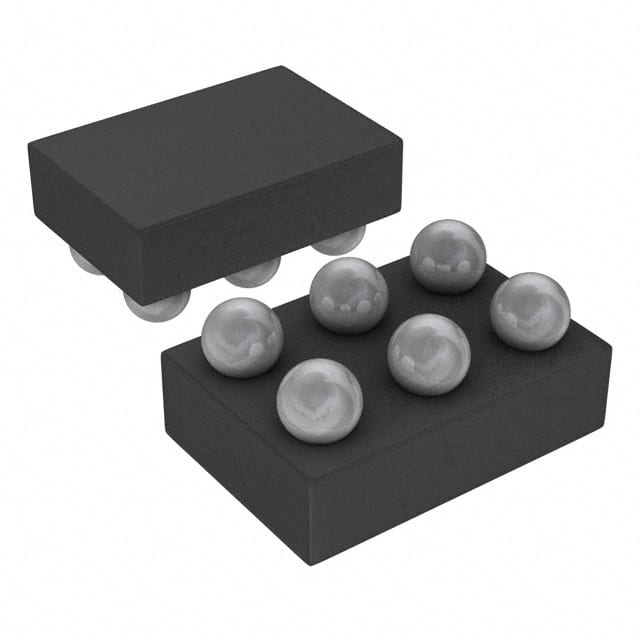NCP436FCT2G - English Editing Encyclopedia Entry
Product Overview
Category: Integrated Circuit (IC)
Use: Voltage Regulator
Characteristics: - Low dropout voltage - High output current capability - Thermal shutdown protection - Overcurrent protection - Reverse polarity protection
Package: SOT-23-5
Essence: The NCP436FCT2G is a voltage regulator IC designed to provide a stable output voltage from an input voltage source.
Packaging/Quantity: Available in tape and reel packaging, with 3000 units per reel.
Specifications
- Input Voltage Range: 2.5V to 6.0V
- Output Voltage Range: 1.2V to 5.5V
- Dropout Voltage: 200mV at 100mA
- Output Current: Up to 500mA
- Quiescent Current: 60µA
- Operating Temperature Range: -40°C to +85°C
Pin Configuration
The NCP436FCT2G has a SOT-23-5 package with the following pin configuration:
```
| | |____| | | ||__ | 1 5 | |_________| ```
Pin 1: Enable (EN) Pin 2: Ground (GND) Pin 3: Feedback (FB) Pin 4: Output (OUT) Pin 5: Input (IN)
Functional Features
- Low Dropout Voltage: The NCP436FCT2G exhibits a low dropout voltage, ensuring efficient regulation even when the input voltage is close to the desired output voltage.
- High Output Current Capability: With a maximum output current of 500mA, this voltage regulator can power a wide range of electronic devices.
- Thermal Shutdown Protection: The IC incorporates a thermal shutdown feature that protects it from overheating, ensuring reliable operation.
- Overcurrent Protection: The NCP436FCT2G includes overcurrent protection, safeguarding the circuit and connected devices from excessive current flow.
- Reverse Polarity Protection: The IC is designed to withstand reverse polarity connections, preventing damage to the device.
Advantages and Disadvantages
Advantages: - Low dropout voltage ensures efficient regulation - High output current capability for powering various devices - Thermal shutdown protection prevents overheating - Overcurrent protection safeguards the circuit and connected devices - Reverse polarity protection prevents damage from incorrect connections
Disadvantages: - Limited input voltage range (2.5V to 6.0V) - Quiescent current of 60µA may impact battery life in low-power applications
Working Principles
The NCP436FCT2G operates as a linear voltage regulator. It regulates the output voltage by comparing the feedback voltage (FB) with a reference voltage. When the output voltage drops below the desired level, the regulator adjusts the pass transistor to maintain a stable output voltage.
Detailed Application Field Plans
The NCP436FCT2G can be used in various applications, including but not limited to: 1. Battery-powered devices 2. Portable electronics 3. IoT devices 4. Automotive electronics 5. Industrial control systems
Detailed and Complete Alternative Models
- LM1117-ADJ: Adjustable Voltage Regulator, SOT-223 package
- LT1763-3.3: Fixed 3.3V Voltage Regulator, SOT-23 package
- TPS79633: Fixed 3.3V Voltage Regulator, SOT-23-5 package
- MCP1700-3302E: Fixed 3.3V Voltage Regulator, SOT-23 package
- LDO50C: Adjustable Voltage Regulator, SOT-23-5 package
These alternative models offer similar functionality and can be considered as substitutes for the NCP436FCT2G in various applications.
Word count: 452 words
Senaraikan 10 soalan dan jawapan biasa yang berkaitan dengan aplikasi NCP436FCT2G dalam penyelesaian teknikal
Sure! Here are 10 common questions and answers related to the application of NCP436FCT2G in technical solutions:
Q: What is the NCP436FCT2G? A: The NCP436FCT2G is a voltage protection device designed to protect sensitive electronic components from overvoltage events.
Q: What is the maximum input voltage that the NCP436FCT2G can handle? A: The NCP436FCT2G can handle a maximum input voltage of 28 volts.
Q: How does the NCP436FCT2G provide overvoltage protection? A: The NCP436FCT2G uses a crowbar circuit to quickly short the input voltage when it exceeds a certain threshold, protecting downstream components.
Q: Can the NCP436FCT2G be used in automotive applications? A: Yes, the NCP436FCT2G is suitable for automotive applications as it meets the necessary standards and requirements.
Q: What is the typical response time of the NCP436FCT2G during an overvoltage event? A: The typical response time of the NCP436FCT2G is less than 1 microsecond.
Q: Does the NCP436FCT2G require external components for operation? A: No, the NCP436FCT2G is a standalone device and does not require any external components for its operation.
Q: Can the NCP436FCT2G be used in high-power applications? A: Yes, the NCP436FCT2G can handle high-power applications with a maximum current rating of 3.5 amps.
Q: Is the NCP436FCT2G suitable for protecting sensitive electronic components such as microcontrollers and ICs? A: Yes, the NCP436FCT2G is specifically designed to protect sensitive electronic components from overvoltage damage.
Q: Can multiple NCP436FCT2G devices be used in parallel for higher current applications? A: Yes, multiple NCP436FCT2G devices can be connected in parallel to handle higher current requirements.
Q: What is the operating temperature range of the NCP436FCT2G? A: The NCP436FCT2G has an operating temperature range of -40°C to +125°C, making it suitable for a wide range of environments.
Please note that these answers are general and may vary depending on the specific application and requirements. It is always recommended to refer to the datasheet and consult with the manufacturer for detailed information.


